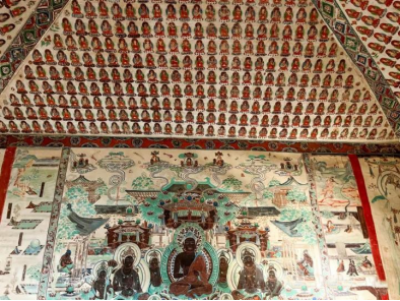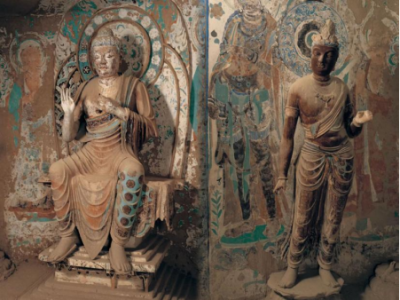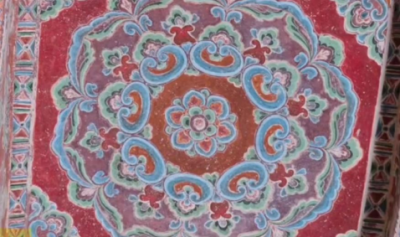Explore 'Gallery in the Desert': Mogao Grottoes Cave 320
The High Tang Dynasty (713-766) stands as a pinnacle of artistic achievement, characterized by vibrant exchanges along the Silk Road that fostered remarkable advancements in Buddhist art at the Mogao Grottoes.

An interior view of Mogao Cave 320 in Dunhuang, Gansu province [Photo provided to silkroadexpo.gogansu.com]
Situated in Dunhuang, Gansu province, the Mogao Grottoes Cave 320 epitomizes the quintessential High Tang aesthetic. The main chamber, square in plan, has a truncated pyramidal ceiling and a niche in the west wall. The ceiling center depicts a peony surrounded by cloud patterns. The four slopes are covered with the Thousand Buddha motifs.
Within the confines of this cave, the existing statues of Buddha, disciples, and Bodhisattvas in the open-mouthed niche are all original works from the High Tang Dynasty.

Two Bodhisattva statues in Mogao Cave 320, distinctly graceful with plump forms and delicate skin. [Photo provided to silkroadexpo.gogansu.com]
The two Bodhisattva statues at the front look very graceful, even though most of their bodies have since been oxidized and discolored. They have plump and lovable forms and delicate skin, which reflects the aesthetic customs of the Tang Dynasty in an incisive and vivid way.
The ceiling of the niche highlights a preaching scene of Maitreya, in which two disciples, four bodhisattvas and two heavenly kings stand in order. There, heavenly kings wear chain mail and tabards which can protect the legs in battles. There is no such example in other preaching scenes in Mogao.
During the Tang era, decorative art flourished, with the Mogao Grottoes serving as a canvas for intricate patterns. Initially, simplified lotus motifs dominated, symbolizing purity as they rise unsullied from the mud. Subsequently, artists melded various flowers, notably the peony, renowned for its beauty and symbolism of grace, opulence, and fortune in Chinese culture.

The Baoxiang Flower design seen in Mogao Cave 320 in Dunhuang, Gansu province [Photo provided to silkroadexpo.gogansu.com]
People call this kind of composite flower design that combines features of the peony, lotus and chrysanthemum as "Baoxiang Flower". It was a common element on gold and silver utensils, embroidery and architecture in ancient China.
The pattern at the heart of the caisson ceiling in Cave 320 is a typical Baoxiang flower. It appears colorful and magnificent, thanks to the technique of overlapping rhymes to blend draperies in red, blue and green colors.
In its entirety, Cave 320 exhibits a harmonious layout, meticulous composition, and an abundance of rich, romantic motifs. It stands as a testament to the grandeur of the Tang Dynasty, fueled by its robust national spirit, economic prosperity, and cultural vibrancy.





 Print
Print Mail
Mail
